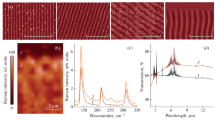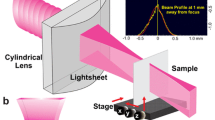Abstract
We propose a simple and fast approach to prepare surface-enhanced Raman scattering (SERS) substrates over a large area with high flexibility by using direct laser writing (DLW) technique. The proposal is demonstrated by the direct fabrication of an array and a complex of symmetry-broken nanocorrals with DLW followed by a metal deposition process. SERS measurements show significant SERS enhancement, which can be controlled through engineering the focused “hot spots” by changing the structural parameters. The experimental observations are further confirmed by our simulations with a finite-difference time-domain tool. The studies can be extended to versatile SERS substrates with arbitrary geometries.




Similar content being viewed by others
References
S. Nie, S.R. Emory, Probing single molecules and single nanoparticles by surface-enhanced Raman scattering. Science 275, 1102 (1997)
J.A. Dieringer, R.B. Lettan, K.A. Scheidt, R.P. Van Duyne, A frequency domain existence proof of single-molecule surface-enhanced Raman spectroscopy. J. Am. Chem. Soc. 129, 16249 (2007)
M. Fan, A.G. Brolo, Silver nanoparticles self assembly as SERS substrates with near single molecule detection limit. Phys. Chem. Chem. Phys. 11, 7381 (2009)
H. Xu, E.J. Bjerneld, M. Kall, L. Borjesseon, Spectroscopy of single hemoglobin molecules by surface enhanced Raman scattering. Phys. Rev. Lett. 83, 4357 (1999)
J.P. Camden, J.A. Dieringer, Y.M. Wang, D.J. Masiello, L.D. Marks, G.C. Schatz, R.P. Van Duyne, Probing the structure of single-molecule surface-enhanced Raman scattering hot spots. J. Am. Chem. Soc. 130, 12616 (2008)
J.N. Chen, W.S. Yang, K. Dick, K. Deppert, H.Q. Xu, L. Samuelson, H.X. Xu, Tip-enhanced Raman scattering of p-thiocresol molecules on individual gold nanoparticles. Appl. Phys. Lett. 92, 093110 (2008)
H.W. Liu, L. Zhang, X.Y. Lang, Y. Yamaguchi, H. Iwasaki, Y. Inouye, Q.K. Xue, M.W. Chen, Single molecule detection from a large-scale SERS-active Au79Ag21 substrate. Scientific Reports 10 (2011)
A. Ahmed, R. Gordon, Single molecule directivity enhanced Raman scattering using nanoantennas. Nano Lett. 12, 2625 (2012)
M.G. Nielsen, A. Pors, O. Albrektsen, S.I. Bozhevolnyi, Efficient absorption of visible radiation by gap plasmon resonators. Opt. Exp. 20, 13311 (2012)
Y.L. Wang, K. Lee, J. Irudayaraj, SERS aptasensor from nanorod-nannoparticle junction for protein detection. Chem. Commun. 46, 613 (2010)
G. Chen, Y. Wang, M.X. Yang, J. Xu, S.J. Goh, M. Pan, H.Y. Chen, Measuring ensemble-averaged surface-enhanced Raman scattering in the hotspots of colloidal nanoparticle dimers and trimers. J. Am. Chem. Soc. 132, 3644 (2010)
C.E. Talley, J.B. Jcakson, C. Oubre, N.K. Grady, C.W. Hollars, S.M. Lane, T.R. Huser, P. Nordlander, N.J. Halas, Surface-enhanced Raman scattering from individual Au nanoparticles and nanoparticle dimer substrates. Nano Lett. 5, 1569 (2005)
L. Liu, Z.H. Han, S.L. He, Novel surface plasmon waveguide for high integration. Opt. Exp. 13, 6645 (2005)
Z.Y. Fang, Q. Peng, W.T. Song, X. Zhu, Plasmonic focusing in symmetry broken nanocorrals. Nano Lett. 11, 893 (2011)
S. Maruo, O. Nakamura, S. Kawata, Three-dimensional microfabrication with two-photon-absorbed photopolymerization. Opt. Lett. 22, 132 (1997)
D. Tan, Y. Li, F. Qi, H. Yang, Q. Gong, X. Dong, X. Duan, Reduction in feature size of two-photon polymerization using scr500. Appl. Phys. Lett. 90, 071106 (2007)
J. Li, B. Jia, M. Gu, Engineering stop gaps of inorganic–organic polymeric 3d woodpile photonic crystals with post-thermal treatment. Opt. Express 16, 20073 (2008)
M.S. Rill, C. Plet, M. Thiel, I. Staude, G. Von Freymann, S. Linden, M. Wegener, Photonic metamaterials by direct laser writing and silver chemical vapour deposition. Nat. Mater. 7, 543 (2008)
M. Thiel, M.S. Rill, G. Freymann, M. Wegener, Three-dimensional bi-chiral photonic crystals. Adv. Mater. 21, 4680 (2009)
H.Z. Yu, H.L. Zhang, Z.F. Liu, Surface-enhanced Raman scattering (SERS) from azobenzene self-assembled “Sandwiches”. Langmuir 15, 16 (1999)
K. Kneipp, H. Kneipp, I. Itzkan, R.R. Dasari, M.S. Feld, Surface-enhanced Raman scattering and biophysics. J. Phys. Condens. Matter 14, R597 (2002)
A. Otto, I. Mrozek, H. Grabhorn, W. Akemann, Surface-enhanced Raman scattering. J. Phys. Condens. Matter 4, 1143 (1992)
A.F. Oskooi, D. Roundy, M. Ibanescu, P. Berme, J.D. Joannopoulos, S.G. Johnson, MEEP: a flexible free-software package for electromagnetic simulations by the FDTD method. Comput. Phys. Commun. 181, 687–702 (2010)
Acknowledgments
This work is supported by the 973 Program of China (Grant Nos. 2009CB930502, 2013CB632704 and 2013CB922404), the National Natural Science Foundation of China (Grant Nos. 91123004, 11104334, 11104342, 50825206, 10834012, and 60801043), the Outstanding Technical Talent Program of the Chinese Academy of Sciences and the Knowledge Innovation Program of the Chinese Academy of Sciences (Grant No. KJCX2-EW-W02).
Author information
Authors and Affiliations
Corresponding authors
Rights and permissions
About this article
Cite this article
Mu, J., Li, J., Li, W. et al. Direct laser writing of symmetry-broken nanocorrals and their applications in SERS spectroscopy. Appl. Phys. B 117, 121–125 (2014). https://doi.org/10.1007/s00340-014-5810-5
Received:
Accepted:
Published:
Issue Date:
DOI: https://doi.org/10.1007/s00340-014-5810-5




